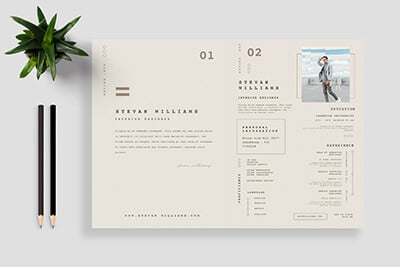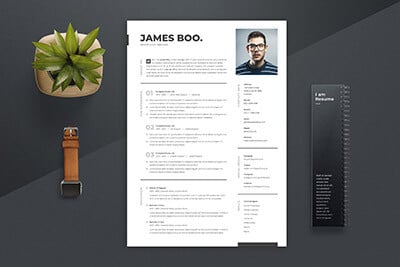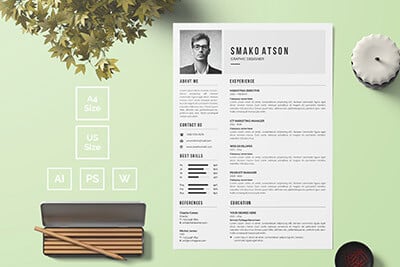5 Tips for a Better Freelance Resume
When was the last time you updated your resume? This is one of those things that freelancers often forget to do when they aren’t seeking a full-time employer.
It’s a lot easier to keep up with your resume all the time rather than rush to update it when the need arises. It’s even becoming more common that clients will ask to see a resume before hiring a freelancer for work. Potential clients will probably check you out online, and your resume needs to be fresh on your website or LinkedIn profile.
Don’t put it off any longer. Try these five tips to freshen up your resume so you can get an updated version ready to go this week!
2 Million+ CV & Resume Templates, Cover Letters + More
Download thousands of resume templates, cover letters, and many other design elements, with a monthly Envato Elements membership. It starts at $16 per month, and gives you unlimited access to a growing library of over 2,000,000 presentation templates, fonts, photos, graphics, and more.
1. Include Lists
Attention spans have gotten shorter, and that includes those of the people looking at your resume. Remember to highlight key items and make lists that are easy to scan, where appropriate.
There are a few places where a list or more graphic style format work particularly well:
- Skills: List skills that relate to your work, such as computer programs that you use (hard skills) or collaboration and management experience (soft skills).
- Achievements/awards: Note all awards, achievements or major publications, but you don’t have to go into detail about each.
- Education and training: Include college information as well as professional training beyond the formal degree.
- Social media or portfolio links: Many jobs care about your profile on social media and other networking websites. Include links to relevant profiles.
- Accomplishments: List anything that’s relevant but doesn’t have another place on your resume. This is a great place to highlight stellar or high-profile projects.
2. Pick a Design Style
Once you’ve gathered all the information you need for your resume and sorted it into “buckets” of information, you need to pick a resume design style that matches your personality. Whether you are more of a minimalist or think a high-design option is better, it can be helpful to pick a couple of options to get started.
That’s where using a template can help, and we’ve previously shared our list of the best CV and resume templates. You won’t have to create multiple designs from scratch – a real time saver – and you can substitute elements quickly.
Most hiring managers agree that a simple format is best. If you are planning to send in a digital copy, make sure your resume is printable. Don’t use too many colors because it can make printing a challenge. (If you opt for a high-color resume design, consider delivering resumes to the recipient to avoid any printing concerns.)
Your resume design should mirror the content therein and help show off your work.
3. Create a Couple of Versions
Most freelancers wear multiple hats, so you might actually need multiple resume versions. Each version should be tailored to a certain type of work or skill.
Here’s a quick example: I am a writer and designer. These skills are pretty different and when taking new writing client, they don’t care so much about my design work and vice versa. I have a resume for each type of client that focuses on what they want to see.
The writing resume is more simple in design, just black text on a white background. The design resume is a little more graphic with a bit of color and a few background elements. But the key difference is in the ranking and priority of content. Make sure the skills and qualifications that are most important for each type of work is at the top of the resume and funnel down to the least important information.
4. Cut All the Crap
The hardest part of designing a freelance (or any) resume is eliminating things. Your resume probably only needs to be one page. That means that you must pare down jobs, tasks, projects, etc. to fit the space.
For starters get rid of these items:
- Objective
- References available upon request
Both elements are obvious and just waste space on your resume.
The best way to clean up your resume is to approach it like you would a design project. What is the problem you are trying to solve? What are your goals? Now use every part of the design to funnel users to that end goal and call to action (which is to contact you for an interview).
Keep that concept in mind and you might be amazed how easy it is to cut things out of your resume. (No one really needs to know you worked at a grocery store in high school, do they?) If it is not vital to the job/client/position at hand, leave it off your resume.
5. Link to Your Work
This might be the most important – and most overlooked – concept: Link to your work from your resume.
Most resumes are submitted in digital formats. (Commonly PDF.) Link items on your resume. Make it easy for potential clients or employers to find the information you are providing, from social media profiles to your online portfolio. Linking will also show your digital-savviness.
At a minimum, your resume should include a fully spelled out link to your portfolio site. (Bonus points if your URL is a version of your name to make it easy and memorable.) Also include relevant links throughout. There is a bit of balance to consider as well: Don’t like to the point of being annoying. Pick a couple of links that are most relevant and stick to those – portfolio, LinkedIn, key project, etc.
Conclusion
Are you ready to update that dusty, old freelance resume? It’s a chore, but a necessary one if you want to keep bringing in quality clients. Make it easy on yourself and start with a template – all of the images in this post are templates you can download. You can find these and plenty of others in our list of the 50 best CV and resume templates.
Freelancing 101 is an occasional series to help the increasing number of freelancers in the market. Whether you are a designer, writer, developer or wear multiple hats, we will share tips, resources and ideas to help you make the most of your small business. Is there something you want to know? Let me know at [email protected].





